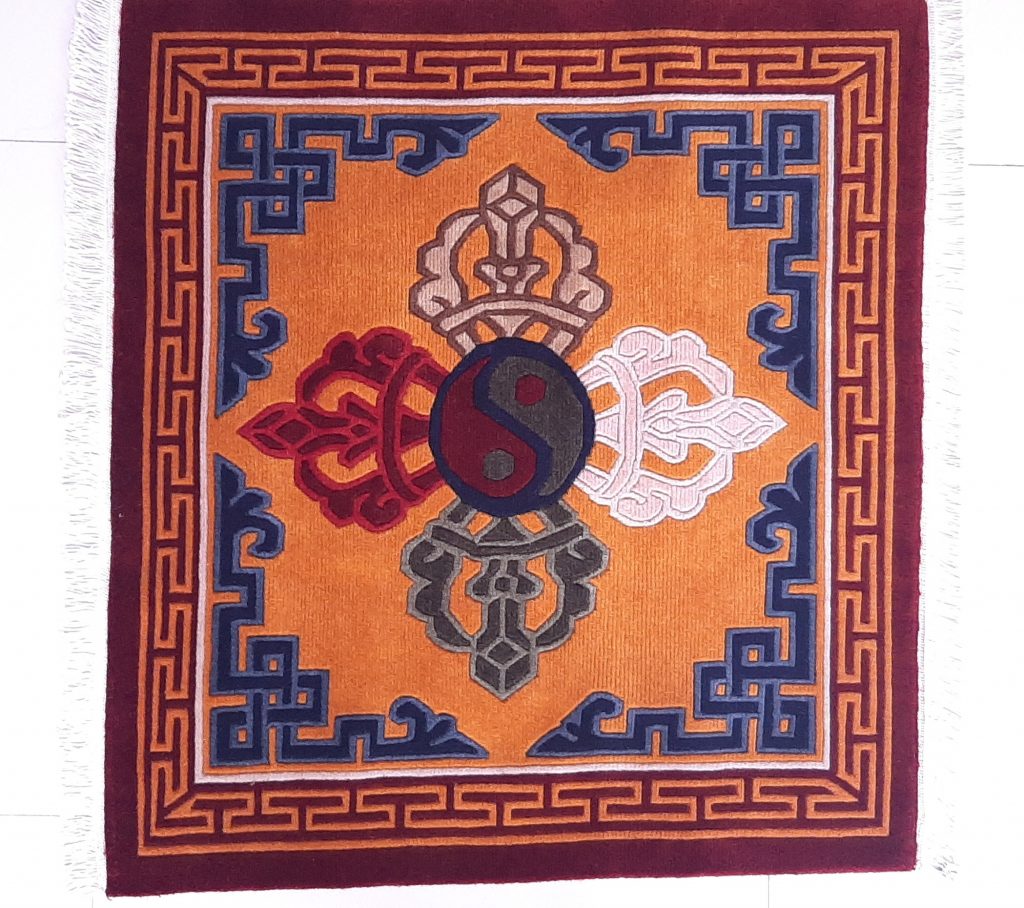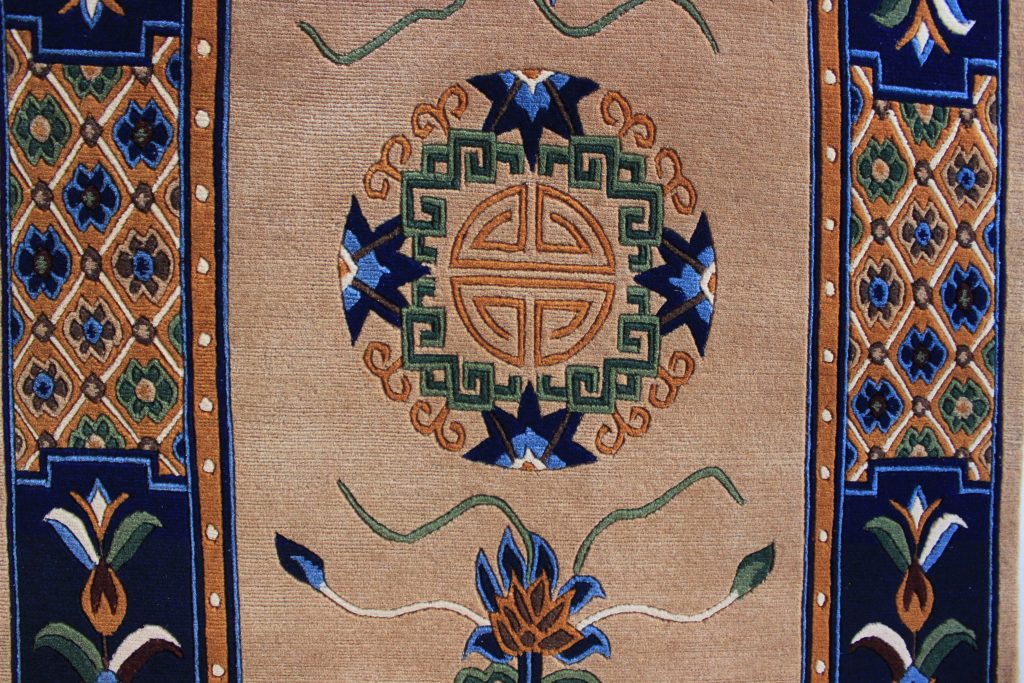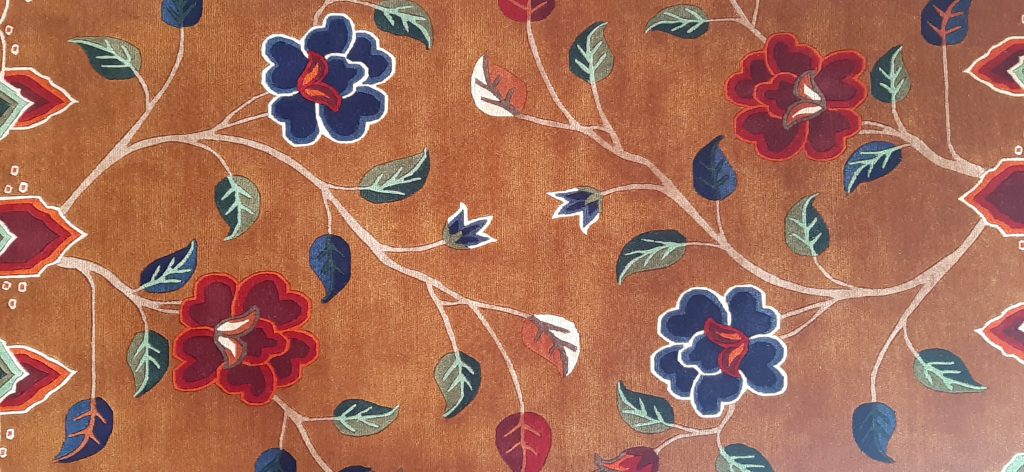
There are mainly two types of Tibetan Carpets or Tibetan Rugs.
One is Tiger Rugs and other is Wangden rugs. At the end of 19th century, the American designers and buyers took great interest in Tibetan style rugs, making Tibetan rugs even more famous.
Because of the modern technologies the Tibetan cultures and tradition have become clearer to the world allowing people to know about their art and culture. Making of the Tibetan rugs is one of the cultures unfold due to the technologies. Each and every rug is special because of their unique, ancient designs. Carefully hand woven Tibetan rug tells us the story of the skills and dedication of craftsmen involved in making them and overall magnificent mysterious art of Tibet.
Types of Tibetan Carpets:
Tiger Rugs:
It is said that the western collectors were more interested in the Tibetan tiger rugs as they used to have striking resemblance to the real tiger skinOne type of these rugs is called the whole pelt which includes the legs and the face of tiger. In the Buddhist culture tigers are commonly seen along with the wrathful deities of Vajrayana tradition. It is believed that the tiger skin provides protection to the person involved in the meditation. On the one hand tiger skins are seen in the male deities while on the other hand leopard skin like rug is seen used in the female wrathful deities.
Wangden rugs:
These types of rugs have looser weave hence the lower knot count and have a thick shaggy fringe. These rugs are said to have their presence widespread at one time but currently they are only woven in the Wangden valley, Tibet. Wangden rugs were originally used by the monks in monasteries as sitting carpets. Wangden carpets differ from knotted Tibetan carpets in both structure and design. The knotting method is unique and the rug backing is ‘warp-faced’.
The wangden rug comes in different types according to size:
- Meditation mats: They are small sized rugs used mostly for single persons meditation or seating purpose.
- Runner rugs: They are longer in length and tends to provide more seating space for multiple people.
- Standard mats: The traditional Tibetan mat size of roughly size 3ft*6ft commonly used as area rug.
- Door mats: They are smaller rugs used commonly for the decorative purpose in the doorway or rooms.
- Door carpets:They are type of carpets used as curtain on door mainly seen on Tibetan Home.
- Customizable size: They are custom sized rugs made upon the demand of the consumer.
Different designs of the Tibetan Carpets:
The traditional Tibetan rugs have large variety of design, pattern and symbols .The Tibetan rug making is not as strict as Tibetan thangka paintings so the weavers have more degree of freedom in combining different symbols and colors. Some of the common designs are:
Medallions:
This design can be found with one or more medallions in the middle or in geometric pattern on the carpet.Typically they come with Tibetan border pattern but some even come in shape of flowers, mandalas like design or even have Chinese symbol of longevity.
Dragons:
The dragon design is one of the traditionally associated with Tibetan pattern. Often believed to bring power, wisdom and good luck the dragons are crafted with same belief into the rug. Dragon on the traditional Tibetan tugs are seen holding the Buddhist jewel on one claw flying in the air. And often enhanced by the designers own color choices and cloud designs.
Flowers:
Floral pattern are one of the main design element in the Tibetan rugs. Even though flowers designs are mostly just taken as decorative designs.They have deep meaning rooted in the Tibetan folk or Buddhism.The mostly commonly seen flowers in the rug are lotus, peach and peonies.
Tibetan Mythical Creatures:
The snow lions and pheonix are believed to common mythical creatures related to the Tibetan folks.Snow lions has been the part of Tibetan flag and also a symbol of identity of the Tibet whereas phoenix is related to part of tibetan palsing yoga (the system of transformation) . Snow lions are usually used as a designing element in the Tibetan rugs generally shown in white color with green or blue mane.
Eight Auspicious Symbols of Buddhism:
The eight auspicious symbols are believed to be the attributes of the goddess of wealth. In Buddhism it refers to the offering given by the great vedic gods to the tathagatashakyamuni Buddha on his enlightenment. Each symbols have their own meanings and are common to be found designed in the rugs.
- The Golden Fishes: They symbolize the beings suffering and happiness
- The Dharma Wheel: It represents the symbol of spirituality and universe.
- The Conch shell: It represents the teachings of enlightenment.
- The Parasol: It symbolizes protection from evil.
- The Lotus: It symbolizes the spiritual unfolding and the purity.
- The Treasure Vase: It represents the spiritual fulfillment.
- The Endless Knot: It represents the meditative mind and Buddha.
- The Victory Banner: Lastly it represents the victory of wisdom while overcoming the problems.
Geometric and Abstract Designs:
These Designs are more modern like creations following the western interior decorations taste.But they are actually traditional designs modified to match the taste of western buyers. A special form of geometric pattern is the checker board design.
Door carpets:
Door carpets are rare Tibetan designs as these designs are not demanded by the western buyers. These designs have same basic pattern as other Tibetan carpets but made as a curtain for door and windows. These types of carpet or curtain are used in harsh and windy places like Tibetan plateau.
If you want to check out our tibetan rug faqs click here and if you want to check out tibetan rugs at our dharma store click here.
 The statue arrived super fast and very well packed. The vibe in my apartment changed immediately into something deeply calming and soothing. As if all the tensions and anxieties have melted. Can’t believe just how majestic he looks. I was already deeply moved by the photo, but when I see the statue with my own eyes…It feels as if Manjushri is right there, with infinite compassion in his infinite wisdom. May all sentient beings be benefitted and realize their true nature.???
The statue arrived super fast and very well packed. The vibe in my apartment changed immediately into something deeply calming and soothing. As if all the tensions and anxieties have melted. Can’t believe just how majestic he looks. I was already deeply moved by the photo, but when I see the statue with my own eyes…It feels as if Manjushri is right there, with infinite compassion in his infinite wisdom. May all sentient beings be benefitted and realize their true nature.???







































































Margeret Madden
Beautiful bowl … quick service very plzed customer Thks ?
margeret madden
antrim, United Kingdom
Review left on Etsy by pinkdolphin2002 on Mar 29, 2016
Lunacywitch
Terrific bowl. Beautifully made with a lovely sound. Lovely bowl. Fast delivery.
Review left on Etsy by lunacywitch on Mar 6, 2020
Check this Product Out!